How To Make Your Own Perfume At Home – 16 Easy Methods
Don't despair if you can't find your favorite fragrance in a store; instead, develop one.
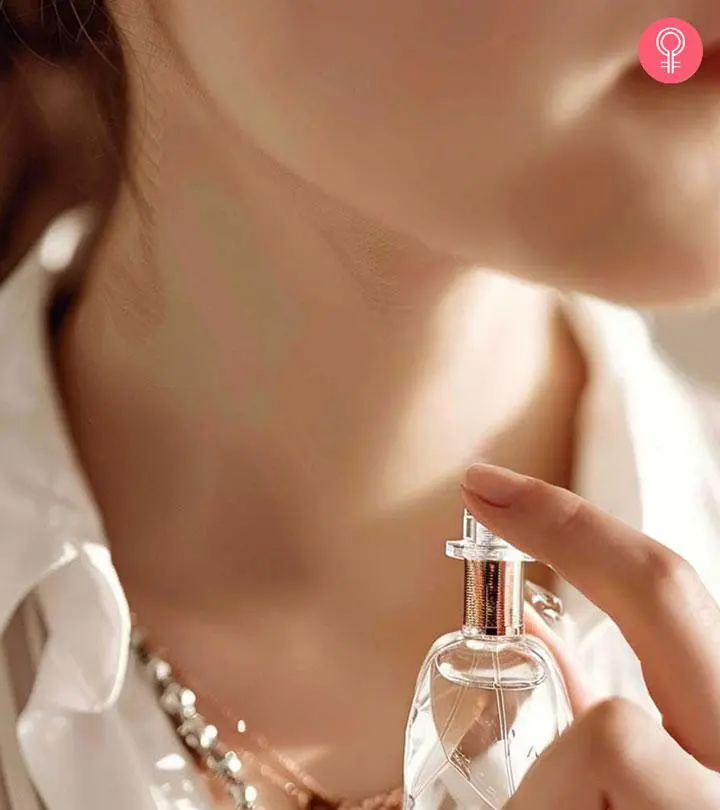
Image: Midjourney/ StyleCraze Design Team
If you are wondering how to make your own perfume, we have got you covered!. A woman’s signature fragrance must be her own and instantly recognizable. Even a small whiff of the best perfumes can be a magical experience, and a little goes a long way. If you want to do something super creative, make your perfume right at home by blending your local grocery store ingredients. You can make sure that your homemade fragrances are not only pleasant but also free from harmful chemicals by using high-quality organic ingredients. When crafting your scent, consider exploring local farmers’ markets or specialty stores for the best selections. This article explains the guide to making your DIY perfume with easy-to-follow directions. They make for great handmade gifts and are one of the simplest DIY projects out there! Scroll down and take a look.
In This Article
Why Should You Make Your Own Perfumes?
Perfumes have long been more than just a way of smelling good; they represent a very strong reflection of personal preferences, and people associate with them their memories, emotions, and identities. Just as no two people are alike, their preferences in perfumes are uniquely theirs, which is why every self-indulging person tried their hands at DIY-ing their perfume or adding to an existing formula. DIY or custom perfumes are sustainable and allow you to pick fragrances that reflect your style.
Research shows that some specific scents impact the activity in the brain and the level of mood or cognitive performance. For example, a lavender scent, with its relaxing fragrances, causes a relaxation-enhancing increase in alpha brain waves, while an invigorating scent like peppermint causes a boosting effect through beta activity (1). So, when someone wants to create their unique aura, a blend of hand-picked ingredients might just do the trick. By tailoring perfumes, you cater to unique emotional triggers, scent sensitivities, and personal associations.
Continue reading to explore some amazing custom fragrances and discover how to make a perfume that suits your unique preferences.
Top 16 DIY Perfume Recipes For Every Woman
- DIY Perfume Recipe Using Essential Oils
- DIY Perfume Recipe Using Flowers
- DIY Citrus Perfume Recipe
- DIY Jasmine Perfume
- DIY Natural Vanilla Perfume Recipe
- DIY Solid Perfume Using Coconut Oil
- DIY Patchouli Perfume Recipe
- DIY Summer Perfume Recipe
- DIY Fruit Roll-On Perfume Recipe
- DIY Rose Perfume Recipe
- Natural Scented Beeswax Solid Perfume Recipe
- Lavender And Vanilla Spring Perfume Recipe
- DIY Bergamot Eucalyptus Roll-On Perfume
- DIY Peppermint And Grapefruit Perfume Recipe
- DIY Vanilla Rose Perfume Recipe
- DIY Cedarwood Perfume Recipe
1. DIY Perfume Recipe Using Essential Oils
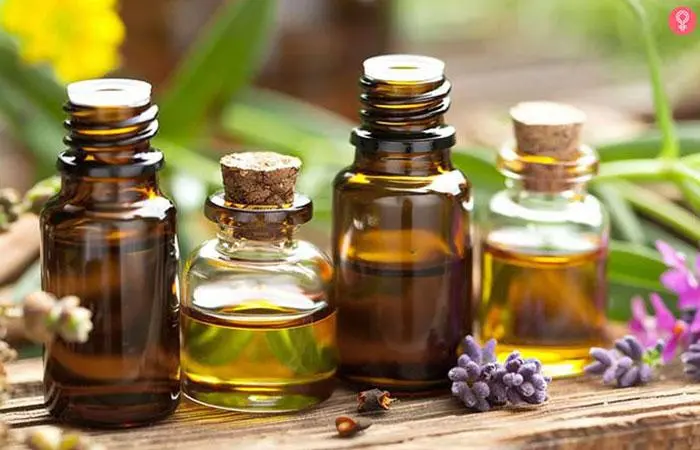
Ingredients And Supplies Needed
- 2 tablespoons carrier oil (grapeseed, jojoba, sweet almond or anything of your preference)
- 6 tablespoons of vodka (100 proof vodka)
- 2.5 tablespoons bottled water
- 5 g of essential oil (0.45g for your top notes, 0.75g for your middle notes, and 0.30g for your base notes)
- A small funnel
- Coffee filter
- 2 clean dark glass bottles with airtight lids
How To Make Perfume Using Essential Oils
- Pour your preferred carrier oilinto one of the glass bottles. Add your base, then the middle, and then the top notes.
- Add the alcohol.
- Secure the lid, and let your perfume sit for a solid 48 hours. (Remember, while making perfume with essential oils, the longer you let it sit, the stronger the scent, so you can leave it for up to 6 weeks if you wish.)
- Once you’re satisfied with the strength of the scent, add the water for dilution, and shake the bottle vigorously for 1 minute.
- Use your filter and funnel to transfer the scent to the other bottle.
Why These Ingredients?
Many essential oils are selected for their unique top, middle, and base notes to create a well-rounded scent profile. Vodka is a preservative that helps dissolve essential oils and enhances the longevity of the perfume. Carrier oil is non-greasy and readily absorbed into the skin. It helps dilute essential oils and ensure safety on the skin.
2. DIY Perfume Recipe Using Flowers
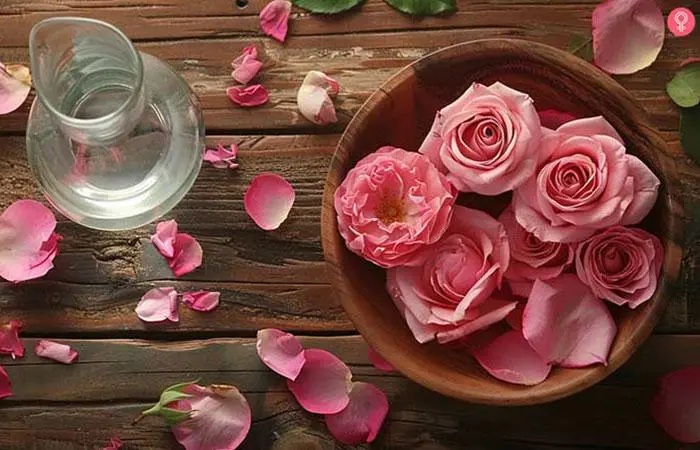
Ingredients And Supplies Needed
- 1 1/2 cups of chopped flowers
- A medium-sized bowl with lid
- 2 cups of distilled water
- Cheesecloth or coffee filter
- A small saucepan
- Washed and sterilized, small glass bottle with an airtight stopper
How To Make Your Own Perfume With Flowers
- Start by gently washing your flower petals, and removing any dirt with water.
- Soak the flowers overnight in a cheesecloth-lined bowl and cover it with a lid for infusion of the plant extracts.
- Squeeze the pouch of flowers over a saucepan for extraction and simmer the extract over low heat until you are left with about a teaspoon of the liquid.
- Pour cold water into this liquid and bottle it up.
- Leave it to set overnight!
Why These Ingredients?
Flowers provide a natural fragrance and a touch of authenticity to your perfume. Learning how to make perfume allows you to experiment with substitutions like lavender or chamomile for a calming aroma.
3. DIY Citrus Perfume Recipe
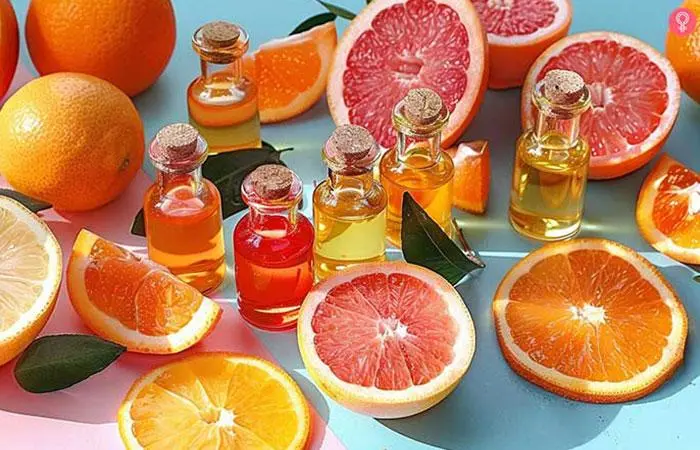
Ingredients And Supplies Needed
- 1 tablespoon of jojoba oil
- 5 g of essential oils – grapefruit, sweet orange, peppermint, and a chamomile/lavender blend
- 2 tablespoons of vodka
- 1 tablespoon of distilled water
- A dark glass container
- A small glass container
- A glass perfume bottle
Steps
- Add jojoba oil to the glass container and then add alcohol.
- For your essential oils, follow this order: For the base note, use 0.5 g of grapefruit oil, 0.5 g of sweet orange oil for the middle note, and then 0.25 g of peppermint oil. For top note, use 0.25 g of chamomile/lavender oil blend or just lavender oil.
- Use a dropper to add distilled water.
- Mix these ingredients well and transfer them to a glass container. Let this sit for 48 hours or longer, as per your preference.
- Transfer to a perfume bottle once it has reached the desired scent.
Why These Ingredients?
Grapefruit and sweet orange oils provide uplifting and fresh notes and jojoba oil is a non-comedogenic carrier that blends well with citrus oils. You may also use coconut oil as a lightweight alternative.
4. DIY Jasmine Perfume
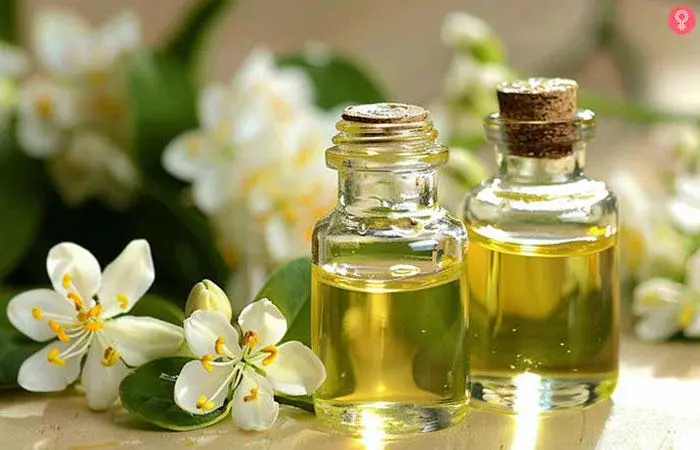
Ingredients And Supplies Needed
- 2 tablespoons of vodka
- 1 tablespoon of distilled water or orange blossom water
- Essential oils – 5 g of jasmine, 0.25 g of lavender, and 0.25 g of vanilla
- 1 glass bottle
- Cheesecloth
Steps
- Mix your essential oil blend with the vodka in a glass bottle.
- Leave the mixture to sit for two days.
- Add distilled water or orange blossom water to the mix and shake gently.
- Leave for about four weeks in a cool, dark spot.
- If you see any sediment, use a cheesecloth for filtering and pour the perfume into a spray bottle.
Why These Ingredients?
Jasmine essential oil is known for its luxurious and floral aroma, making it a perfect choice for an elegant fragrance. The orange blossom water complements jasmine’s sweetness. You can use rosewater instead as well.
5. DIY Natural Vanilla Perfume Recipe
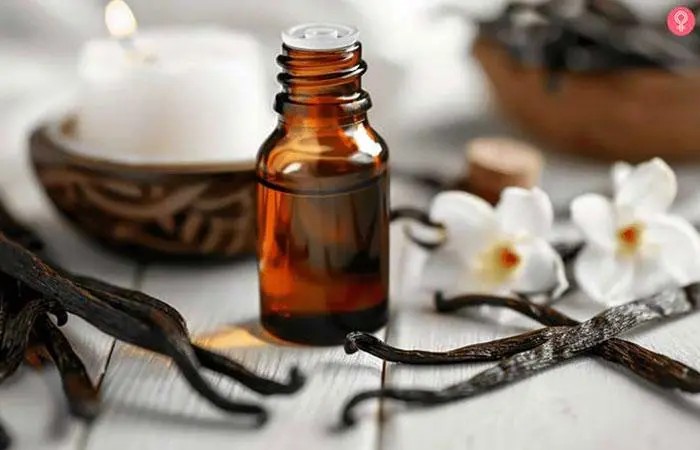
Ingredients And Supplies Needed
- 1 vanilla bean
- 3 to 4 tablespoons of organic sunflower oil
- 2 g of bergamot essential oil
- Cedarwood and anise essential oil
- Glass containers
Steps
- Start by slicing open a vanilla bean, scrape out the seeds from the pod, and cut them up nicely into tiny pieces.
- Place these pieces in a glass bottle and add your organic sunflower oil.
- Close your bottle tightly and let it sit in a cool, dark place for two weeks (shake the bottle gently once every 3-4 days). This process of allowing the fragrance of the ingredients to blend with the solvent is known as maceration.
- After two weeks, add bergamot, cedarwood, and anise essential oil to a glass spray bottle.
- Use a dropper to get the vanilla-infused oil out without getting the seeds.
- Add this to your glass spray bottle and finally, gently shake the blends together.
Why These Ingredients?
Vanilla bean offers a rich, warm, and inviting scent and the bergamot oil adds a fresh, citrusy contrast to vanilla’s sweetness. For a spiced twist, you can go ahead with cinnamon or nutmeg oil. Coconut oil can be also used as a nourishing carrier.
6. DIY Solid Perfume Using Coconut Oil
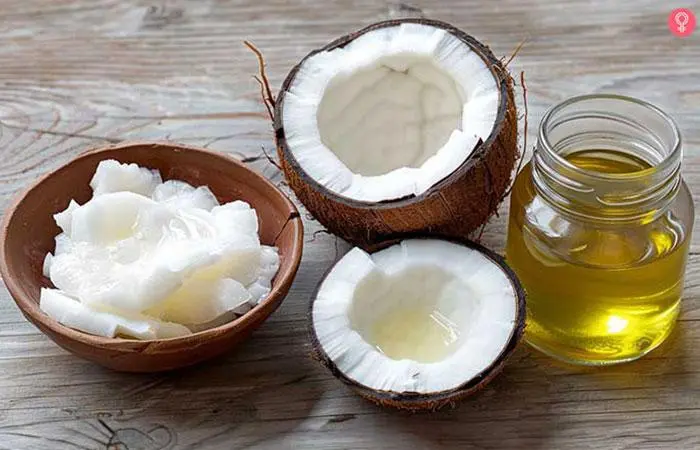
Ingredients And Supplies Needed
- 2 tablespoons of beeswax
- 2 tablespoons of fractionated coconut oil
- 1 g of your favorite essential oil
Steps
- Add fractionated coconut oil and beeswax to a glass jar.
- Place the jar in a saucepan with about 2 inches of boiling water.
- Stir ingredients until combined.
- Once it has melted, remove from heat and let it rest for 3-4 minutes.
- Add your essential oil and stir well.
- Pour this into a container, and to use, apply a small amount to your skin.
Why These Ingredients?
Beeswax is a solid perfume base, which helps blend all the ingredients evenly. It has a light, honey-like fragrance that may add to the overall fragrance profile. You can substitute beeswax with candelilla wax for a vegan-friendly option. Fractionated coconut oil ensures a smooth application. This oil is odorless and lightweight, which allows it to absorb quickly into the skin without leaving a greasy residue. You can also use shea butter instead of coconut oil for a creamier texture. And for the perfume’s scent notes, use essential oils of your choice. For a fresh and romantic perfume, try rose or lavender. For a citrus smell, go for lemon and bergamot. Woody and spicy oils have a warm earthy aroma.
7. DIY Patchouli Perfume Recipe
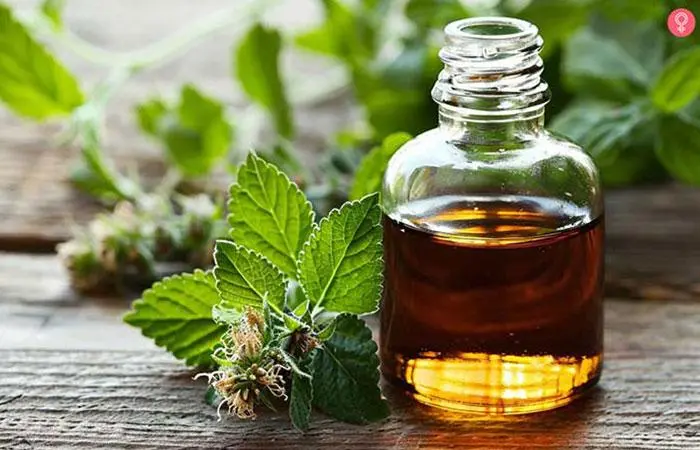
Ingredients And Supplies Needed
- 2 tablespoons of vodka
- 1 tablespoon of distilled water
- A dark glass bottle
- Essential oils – 1 g of sweet orange oil, 0.5 g of patchouli oil, 0.5 g of cedarwood oil, 0.25 g of lavender oil, 0.25 g of ylang-ylang oil, 0.25 g of bergamot oil
Steps
- Start by combining your alcohol and distilled water into the dark glass bottle.
- Add a drop of your essential oil, and stir that drop into the mixture (the idea is to stir each drop slowly into the alcohol, so the oils thoroughly disperse in it.)
- Once you finish, let it sit for about two days.
- Gently shake it before you use the perfume!
Why These Ingredients?
Patchouli oil creates a classic base note with a rich, earthy aroma. The cedarwood oil adds a woody depth and balances the patchouli’s intensity.
8. DIY Summer Perfume Recipe
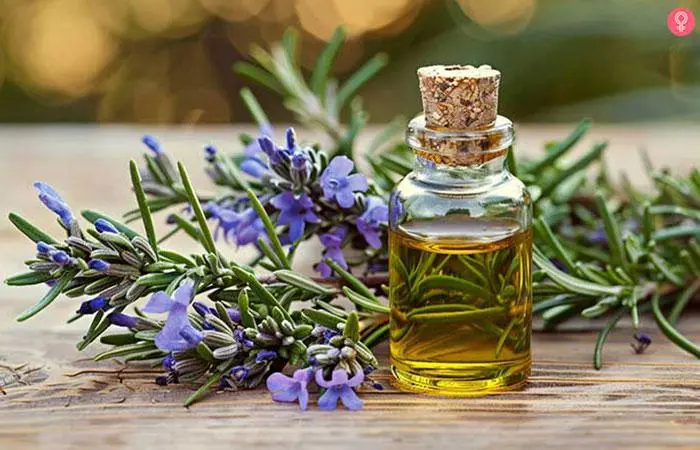
Ingredients And Supplies Needed
- 65 g of peppermint essential oil
- 65 g of rosemary oil
- 25 g of lemon essential oil
- 25 g of sage essential oil
- 3 tablespoons of vodka
- 2 cups of distilled water
Steps
- Mix all your essential oils in a glass bottle that contains your 100-proof alcohol.
- Gently shake and let the bottle sit for about two days.
- Add the distilled water, mixing slowly until it’s completely dispersed.
- Leave your perfume to sit for 2-3 weeks in a cool, dark place.
- After your perfume matures, remove any kind of sediment using a filter and store it in a pretty glass spray bottle.
Why These Ingredients?
Rose petals are a natural and delicate source of fragrance. Instead of roses, you may use jasmine or lilies for a different floral profile. The vodka helps capture and preserve the essence of the flower.
9. DIY Fruit Roll-On Perfume Recipe
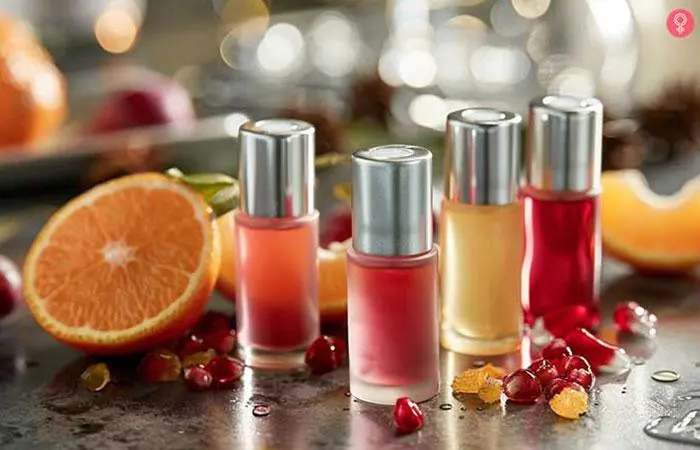
Ingredients And Supplies Needed
- A 5 ml roll-on bottle
- 15 g of mandarin essential oil
- 1 g of sweet orange essential oil
- 15 g of neroli essential oil
- 1 g of cedarwood atlas essential oil
- 1 teaspoon of liquid carrier oil (grapeseed oil or fractionated coconut oil)
Steps
- Start by dropping your essential oils into a bottle and gently swirl around to mix.
- Add your carrier oil.
- Transfer this to a roller bottle.
- Put the lid on and roll between your hands to mix.
- Roll onto your wrists and behind your ears to use.
Why These Ingredients?
Mandarin oil is an uplifting and refreshing sweet citrus oil that is most often used to relieve stress and anxiety. Sweet orange essential oil is a sweet energizing citrus aroma that also cheers your mood and increases your energy. The neroli essential oil is extracted from the bitter orange flower and has a floral, honey-like fragrance. If you want something more floral, you can use lavender or rose essential oils in place of neroli.
 Trivia
Trivia10. DIY Rose Perfume Recipe
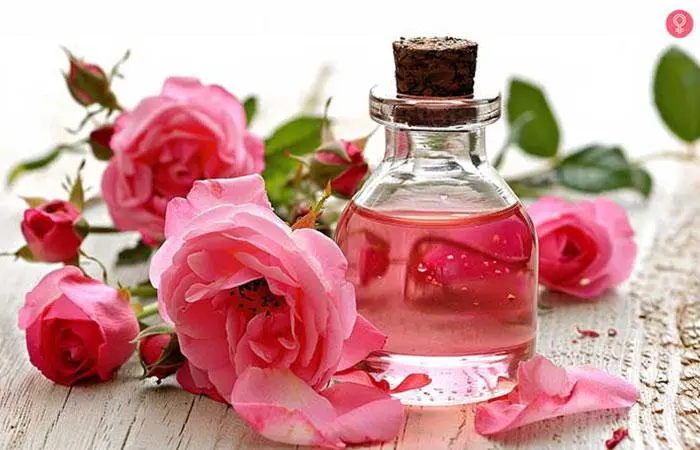
Ingredients And Supplies Needed
- 3/4 cup of fresh rose petals
- 1/2 cup of 100-proof vodka
- 2 1/2 cups of distilled water
- 1-0.15 gramsof rose essential oil
- A big glassjar with a lid
- A glass perfume bottle
Steps
- Start by placing your rose petals at the bottom of your glass jar and pour the vodka over it.
- Cover this up and let it sit for a day in a cool, dark place.
- Use a spoon to squish the petals and add the distilled water into the jar as well as the essential oils.
- Cover the bowl and leave it to sit for 5-7 days, making sure you mix it once a day.
- Once this concoction has been sitting for a week, strain the mixture into a glass perfume bottle. Shake well, and it’s ready to use!
Why These Ingredients?
Rose petals are a classic choice for perfume-making due to their romantic, delicate scent. Vodka helps to extract the scent from the rose petals while ensuring the longevity of the perfume. Rose essential oil heightens the scent profile of the perfume.
11. Natural Scented Beeswax Solid Perfume Recipe
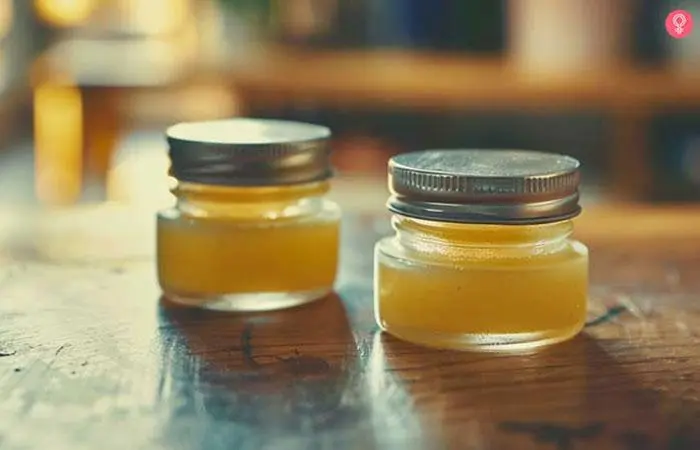
Ingredients And Supplies Needed
- 1 tablespoon of carrier oil (almond)
- 2 teaspoons of beeswax pellets
- 5-2 g of essential oils of your choice
Steps
- Place a glass bowl on top of a pan partially filled with water. Simmer over medium heat. Place the oil and beeswax in the glass bowl, and allow the beeswax to melt.
- Remove the bowl from the heat source, and stir.
- Pour the liquid into a container or tin.
- Once your liquid begins to cool, add the essential oil(s) of your choice. Gently stir and place the lid back on your container to keep the oils from evaporating.
- Allow the perfume to solidify before use. And as the perfume matures, the scent intensifies.
Why These Ingredients?
Almond oil is gentle and has a mild, sweet aroma that pairs well with essential oils. It is also known for its moisturizing properties. Beeswax helps to solidify the perfume and in sealing in the fragrance, allowing it to last longer. You can also experiment with other essential oils like frankincense, bergamot, or ylang-ylang for different scent profiles.
12. Lavender And Vanilla Spring Perfume Recipe
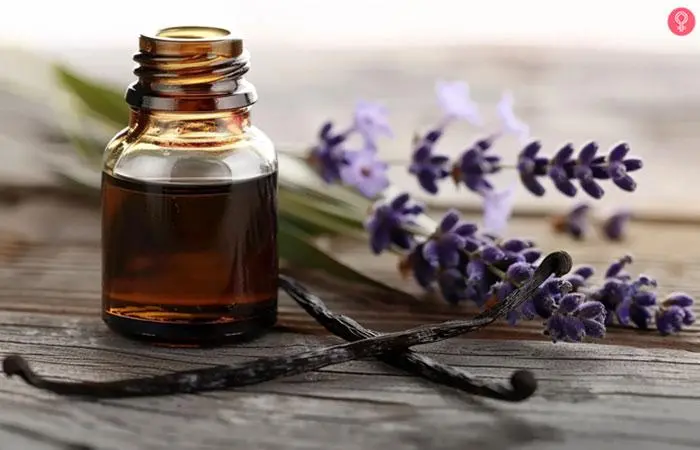
Ingredients And Supplies Needed
- 1/2 cup of 100-proof vodka
- 1 cup of dried lavender flowers
- 2 vanilla beans
- 2 tablespoons of vegetable glycerin
- 75 g of lavender essential oil
- 5 g of vanilla extract
Steps
- Start by slicing open the vanilla beans using a knife.
- Place the beans and the lavender flowers in a glass jar.
- Pour your alcohol into the jar and secure it with a lid.
- Let this mixture infuse for seven days.
- Strain and discard the beans and flowers.
- Add glycerin, lavender essential oil, and vanilla extract to the reserved liquid and stir.
- Allow the perfume to age for four to six weeks.
- Strain the perfume and transfer it to a spray bottle.
Why These Ingredients?
Lavender flowers are known for their calming and soothing properties and offer a fresh fragrance. Vanilla beans provide a warm, comforting scent that blends well with almost any other fragrance. Glycerin is used to increase the shelf-life of the perfume. If you prefer a spicier or sweeter scent, you can substitute the vanilla with cinnamon or clove essential oil.
13. DIY Bergamot Eucalyptus Roll-On Perfume
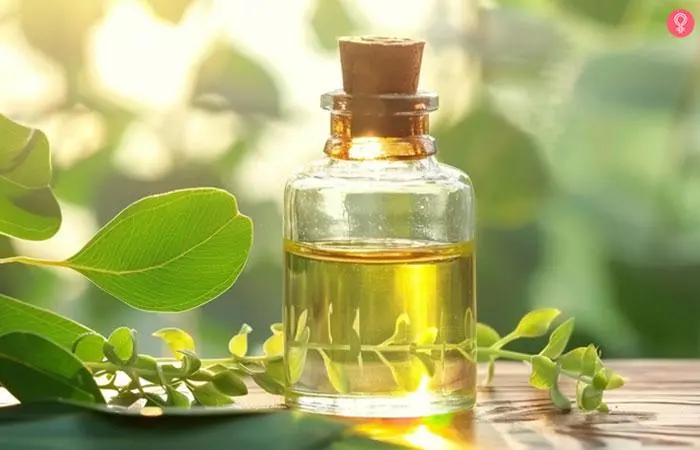
Ingredients And Supplies Needed
- 2 teaspoons ofJojoba oil
- 15 g of eucalyptus essential oil
- 1 g of bergamot essential oil
- 05 g of rosemary essential oil
- 05 g of pine essential oil
- 05 g of mandarin orange essential oil
Steps
- Add the essential oils to your roll-on bottle.
- Use an eyedropper to add jojoba oil to the shoulder of the bottle.
- Replace the roll-on ball and lid, and shake the bottle gently until the contents are properly blended.
Why These Ingredients?
Jojoba oil is an excellent carrier oil because it is a great moisturizer and non-irritating to all skin types. Eucalyptus essential oil has a refreshing, invigorating scent and is also widely used to clear congestion. Bergamot has a fresh citrus fragrance with a hint of flower that gives the perfume a slightly floral note. You could replace bergamot with lemon or lime for a stronger citrusy flavor. If you prefer something woody, use cypress or sandalwood.
14. DIY Peppermint And Grapefruit Perfume Recipe
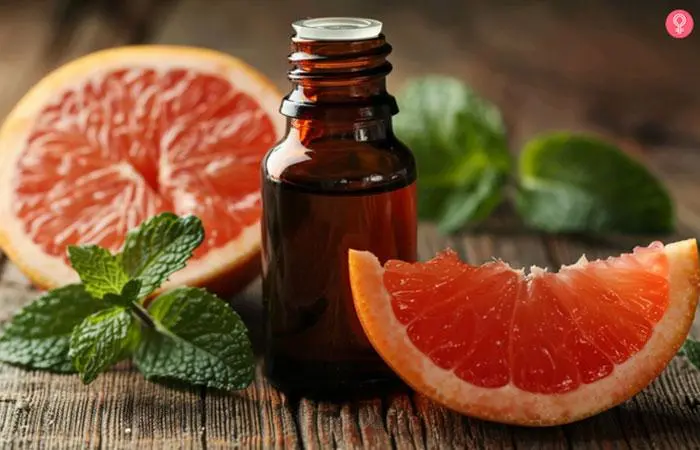
Ingredients And Supplies Needed
- A small glass container
- A dark glass container to store
- A glass perfume spray bottle
- 1 tablespoon of jojoba oil
- 2 tablespoons of pure grain vodka or perfumer’s alcohol
- 5 g of essential oils– grapefruit, peppermint, sweet orange, and a chamomile/lavender blend
- 1 tablespoon of distilled water
Steps
- Add the jojoba oil to the glass container and then add your alcohol.
- Add the essential oils in the following order: base note – 0.5 g of grapefruit oil, middle note – 0.5 g of sweet orange oil and 0.25 g of peppermint oil, top note – 0.25 g of chamomile/lavender oil blend.
- Use a dropper to add distilled water.
- Mix this well and transfer it to a dark glass container. Store this for two days or up to six weeks.
- Transfer your perfume to a pretty glass spray bottle once it reaches your desired scent.
Why These Ingredients?
Peppermint essential oil gives off an icy, refreshing, and energizing smell that boosts the senses. The tangy and sweet, citrus-like scent of grapefruit oil brightens the mood. Chamomile and lavender balance the zesty citrus and mint aromas, making it suitable for calming or soothing.
15. DIY Vanilla Rose Perfume Recipe
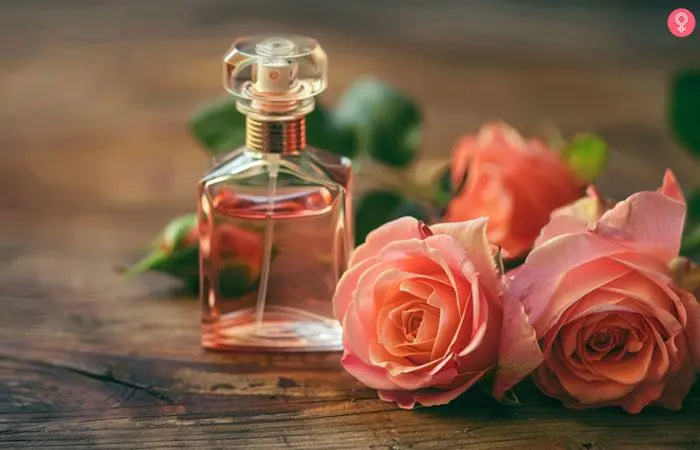
Ingredients And Supplies Needed
- A handful of fresh or dried rose petals
- A handful of fresh or dried lavender
- 1 vanilla bean
- 100 proof vodka
Steps
- Combine your flowers and vanilla in a clean, glass mason jar.
- Pour enough vodka to cover the dried flowers until they float.
- Put the lid on and let it sit for four to six weeks, then strain the flowers. The resulting liquid is known as a tincture, which is a concentrated extract of the flower.
- Strain the liquid and pour it into a glass spray bottle.
Why These Ingredients?
Rose petals give a gentle, floral scent and lavender adds depth and fresh herbal notes to the perfume. Lavender can be replaced with chamomile for a sweeter blend. Vanilla beans give the perfume unique undertones.
 Quick Tip
Quick Tip16. DIY Cedarwood Perfume Recipe

Ingredients And Supplies Needed
- 2 tablespoons of vodka
- 1 tablespoon of distilled water
- Essential oils – 1 g of cedarwood oil, 0.5 g of clear sage oil, 0.5 g of rosemary oil, 0.25 g of lemon oil
- A dark glass bottle
Steps
- Start by adding vodka and distilled water into the dark glass bottle and let it sit for a bit.
- Then, add all the essential oils into it drop by drop. Continuously stir the mixture as you add the oils to ensure they thoroughly disperse into it.
- Once done, close the bottle and let it sit for at least two days in a cool and dark place.
- Gently shake the bottle before you use the perfume.
Why These Ingredients?
Cedarwood oil offers a woody and earthy base note that is perfect for creating a balanced fragrance. Clary sage oil adds an herbaceous and slightly floral middle note, adding depth to the fragrance. Lemon oil gives a bright, zesty top note. You can substitute the cedarwood with sandalwood for a softer base note.
Different types of perfumes, whether floral, citrus, or woody, all require proper care and storage. Check out the next section to learn some tips on how to make your perfume a success!
Key Takeaways
- Customize and add uniqueness to your homemade perfume with essential oils.
- Always use 100-proof vodka or perfumer’s alcohol while making perfumes at home.
- Storing perfumes in glass containers in refrigerators or dark, cool places helps them last longer.
- Measure the ingredients properly before you pour them to get the desired results.
Tips To Make Sure Your Perfume-Making Is Successful
Follow these tips to be a pro at perfume-making in no time!
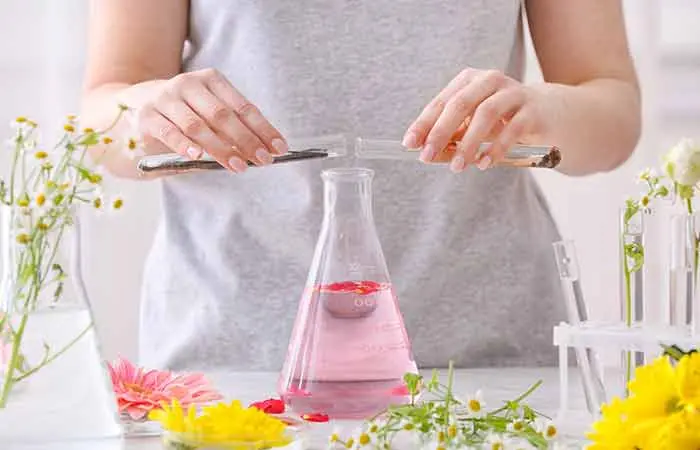
- Understand The Basics Of Perfume Composition
Before diving into the process, it’s crucial to grasp the notes used in a fragrance. Perfumes are composed of three layers, the top notes, heart notes, and base notes. The top notes are the initial scents that evaporate quickly, such as citrus or mint. Heart notes emerge as the top notes fade and often consist of floral or fruity scents. Finally, base notes linger the longest, offering deep, rich scents like sandalwood or vanilla.
- Choose High-Quality Ingredients
The quality of your raw materials impacts the final product. Whether you’re using essential oils, fragrance oils, or alcohol, make sure you’re sourcing the best possible ingredients. Synthetic fragrances can also be used but should be chosen carefully to avoid harsh chemical smells.
- Start Small And Keep A Perfume Journal
When you are just starting out, it’s wise to create small batches and test different combinations. Keep a detailed journal documenting your measurements, ingredient combinations, and aging times. This will help you track your progress, understand what works, and replicate successful blends in the future.
- Balance Your Notes Properly
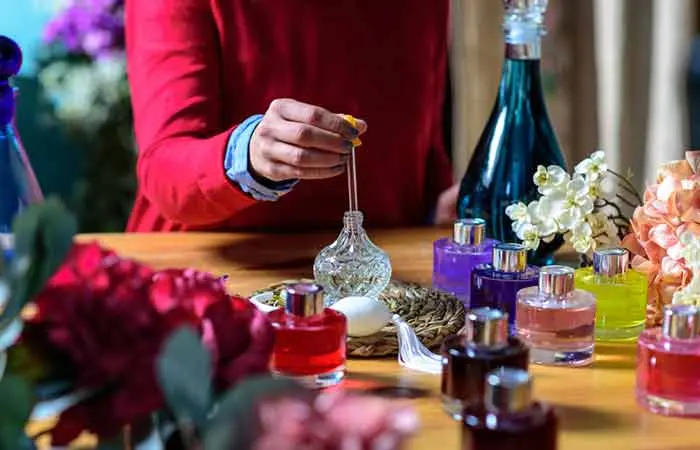
A well-balanced perfume doesn’t overwhelm the senses. As a rule of thumb, start with a 30% top notes, 50% heart notes, and 20% base notes ratio. However, don’t be afraid to deviate from this standard based on the mood or occasion you’re creating the perfume for.
- Master The Art Of Layering
Layering is the technique of combining different perfumes or scents. You can mix multiple oils or perfumes to see how they interact with each other. Start by combining scents from similar families, such as different floral or citrus fruit smells, then branch out into more complex pairings.
- Test On Your Skin
While testing on paper blotters can give you a general idea of your perfume’s structure, it’s essential to apply it to your skin as well. Fragrances react differently based on an individual’s body chemistry that may alter the scent’s longevity and intensity. Always test on your pulse points, such as the wrist or neck, and evaluate how the perfume develops throughout the day.
As you master the art of perfume-making, it is also important to learn how to store your fragrances. Learn more in the next section.
Tips: Making And Storing Your Homemade Perfume
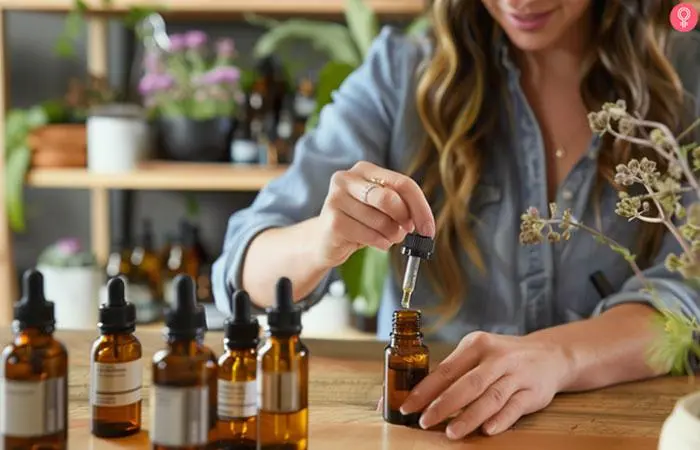
You don’t have to spend a ton of cash to smell good. Now that you have a bunch of exciting perfume recipes to try out, here are a few tips that you should keep in mind while making and storing your creations.
- Set up a proper workstation – it doesn’t have to be anything fancy, but a clear table where you can measure ingredients with ease is important.
- Prepare your bottling supplies by buying glass bottles with airtight lids and spray dispensers before you start your project.
- Always use perfumer’s alcohol (96% denatured alcohol) or 100 proof vodka for your perfumes because – the higher the percentage of alcohol, the better the outcome.
- It’s best to use only glass containers and bottles while making your perfume because essential oils can break down plastic, which in turn can destroy the oil. If you want to fully enjoy the benefits of using perfumes and make them last longer, always choose glass.
- Perfume oils with a strong aroma work best in the manufacturing of perfumes.
- The effectiveness of your perfume completely depends upon the ratio of essential oils, alcohol, and drinking water used in blending the mix – so make sure you measure well before adding anything, because a little less, or not enough, will change the entire sign of your perfume.
- Perfume is like fine wine, and it needs to remain and mature before it reaches excellence.
- You can also extract essential oils from raw materials like flowers and herbs using the process of distillation. It involves boiling the raw material and collecting the steam which contains the perfume oil.
- If making perfume in big batches, you can use fixatives like resins, balsams, or musk ketone, which bind to the fragrance compounds and extend their lifespan. Finish off with labeling and packaging to launch your own homemade perfume brand.
Sarah, a blogger, shared her experience of making her own fragrance. Reflecting on the process, she said, “In the process of making it, a genuine intuition arose. After many initial experiments, I gained a significant sense of what to drop in next, or what proportions to alter. It was no longer a random trial. This experience has given me a great drive to play at perfumer again (i).”
The experience of making your own perfume can be a memorable and satisfying experience. And it can be perfectly so if you know which common mistakes to avoid and what safety measures to take. Learn all about these in the section below.
Precautions For Safe DIY Perfume Making
This enjoyable endeavor of making your own perfume comes with its own set of potential risks that should not be overlooked. Below, we go deeper into the important considerations you should take into account as you begin this fragrant adventure.
- Many synthetic fragrance components are known to pose health risks. These include respiratory issues and skin irritations. So, research well and choose your materials carefully.
- If you are mixing ingredients, use gloves and goggles to protect against spills or splashes that could irritate the skin or eyes.
- Individuals may react differently to certain fragrance ingredients. This may include symptoms like rashes or headaches. So, perform a patch test on a small area of your skin before making a batch to identify sensitivities.
- Many of the commonly used solvents, such as denatured alcohol or isopropyl alcohol, can be toxic if absorbed through the skin or ingested. Such substances can cause irritation or other adverse health effects. So, it is better to choose safer alternatives specifically designed for cosmetic use. In DIY recipes, vodka can be a safe alternative.
- Homemade perfumes may not be consistent in terms of scent and quality because of the variability in sourcing ingredients and blending techniques. So, manage your expectations accordingly.
- Work in a well-ventilated area to avoid inhalation of possibly dangerous fumes produced when mixing the perfume. Good air circulation ensures a safe environment.
- Label your perfumes with all ingredients used and store them in a cool, dark place, away from any heat source. Proper storage ensures their integrity is maintained and degradation does not occur over time.
Though making perfume at home is an excellent opportunity to be creative and express yourself, it is also important to enter this craft with awareness and caution. Understanding the possible risks involved and the limitations of DIY formulations is crucial, and taking the right precautions will give you a safe and rewarding perfume-making experience.
Infographic: DIY Perfuming: 5 Amazing Ingredients To Try
Who doesn’t love a good fragrance? But it can be tricky when you don’t find a scent that intoxicates your senses and leaves you smiling all day long. Well, it’s time to change that by making your own perfumes.
Check out the infographic below to learn the best ingredients to curate your fragrance with! Illustration: StyleCraze Design Team
Making your DIY perfume in the comfort of your home is a great thing to do. You can get creative with the ingredients you use and come up with a unique scent. When you make perfumes at home, you can customize the product as per your needs and likes. Besides, you can also avoid using harmful chemicals and ingredients that may cause allergies. The DIY perfume recipes listed above will help you make a unique fragrance that suits your personality. These are simple recipes that you can try with easily available ingredients.
Frequently Asked Questions
What ingredient makes perfume last longer?
The correct ratio of essential oils and alcohol makes perfume last longer, so how long the perfume lasts directly depends on this balance.
Can I mix alcohol with essential oils?
Yes, you can mix perfumer’s alcohol or vodka with essential oils to make perfume.
What are the best-smelling essential oils?
Lavender, sandalwood, lemon, and frankincense are some popular essential oils that smell nice.
Want to make your own perfume? Watch this video on easy ways to create your own signature scent using simple ingredients!
Personal Experience: Source
StyleCraze's articles are interwoven with authentic personal narratives that provide depth and resonance to our content. Below are the sources of the personal accounts referenced in this article.
i. Make Your Own Perfume – The Magnificent Perfume Making Experiment, Part 4, The Result.
https://odiferess.blogspot.com/2013/10/make-your-own-perfume-magnificent_27.html
References
Articles on StyleCraze are backed by verified information from peer-reviewed and academic research papers, reputed organizations, research institutions, and medical associations to ensure accuracy and relevance. Read our editorial policy to learn more.
- Influence of Fragrances on Human Psychophysiological Activity: With Special Reference to Human Electroencephalographic Response
https://pmc.ncbi.nlm.nih.gov/articles/PMC5198031/
Read full bio of Cláudia Camacho
Read full bio of Esha Saxena
Read full bio of Subhrojyoti Mukherjee
Read full bio of Joyce Joyson






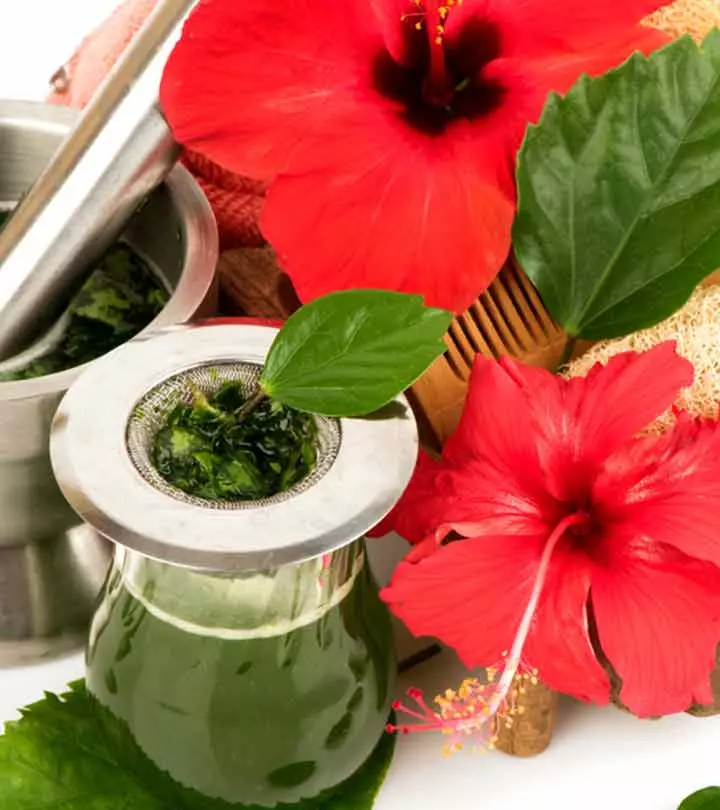

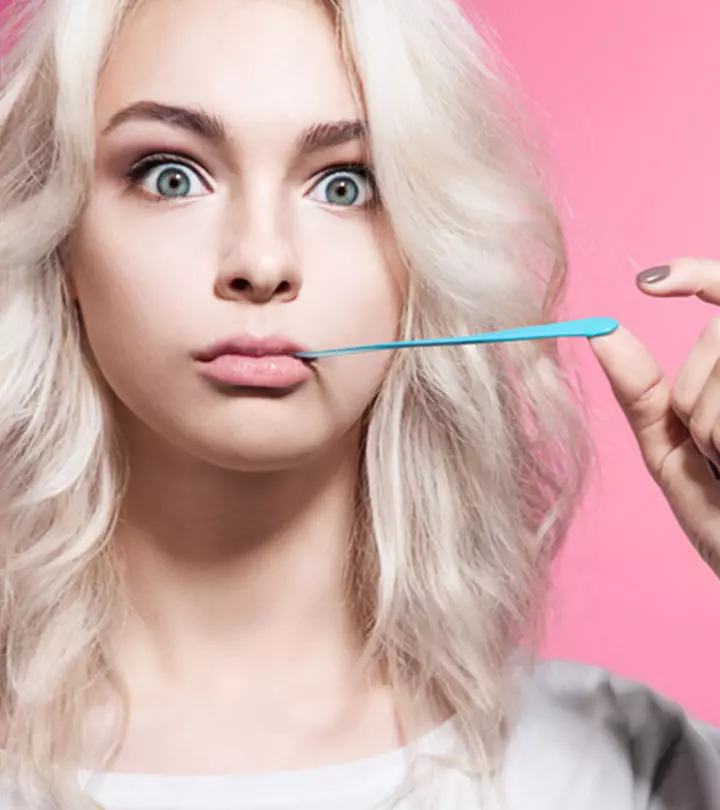
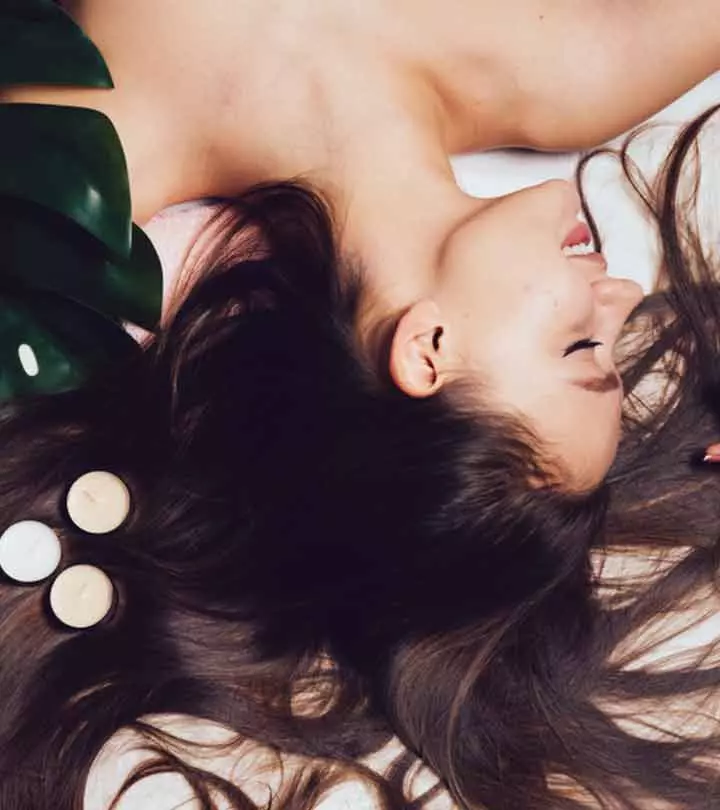
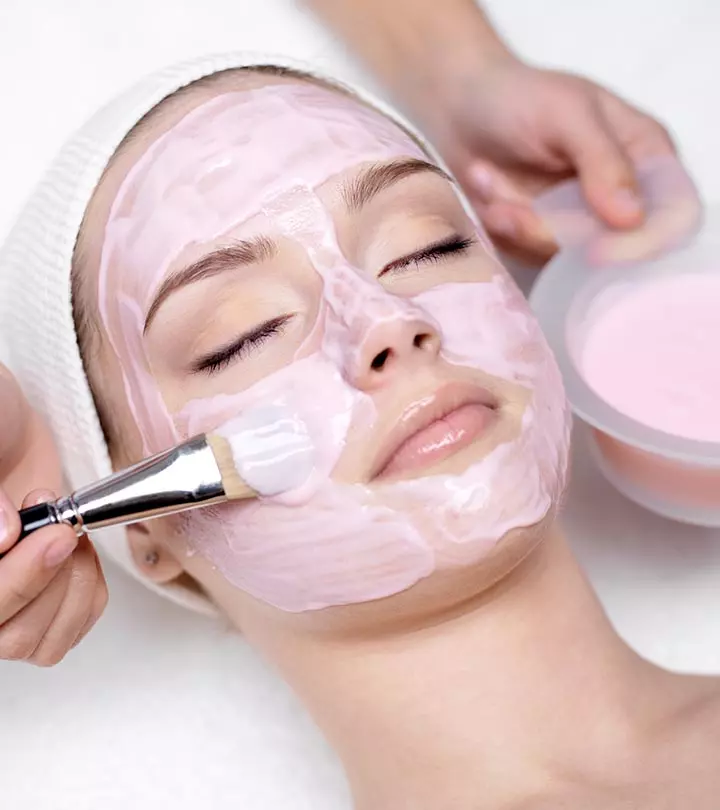
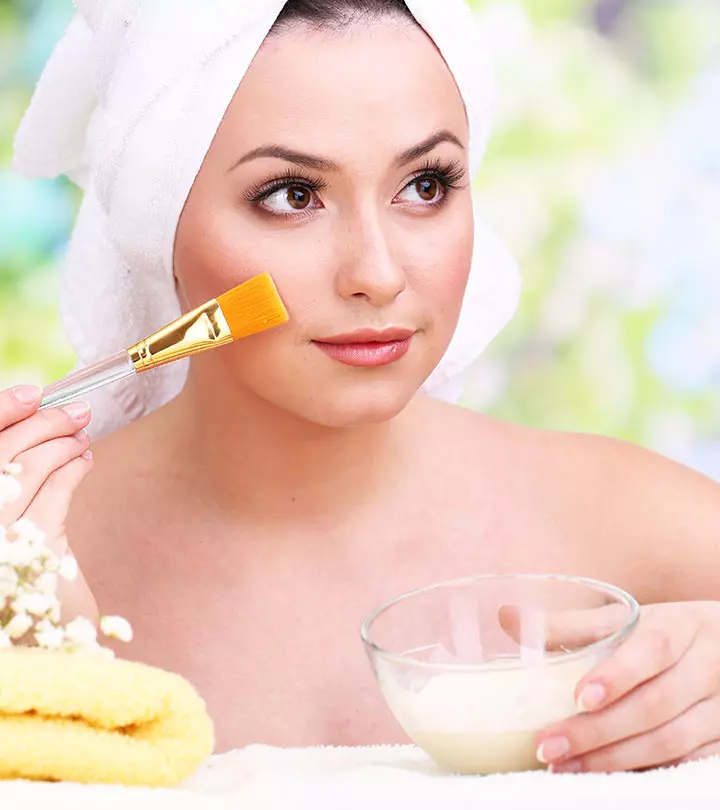
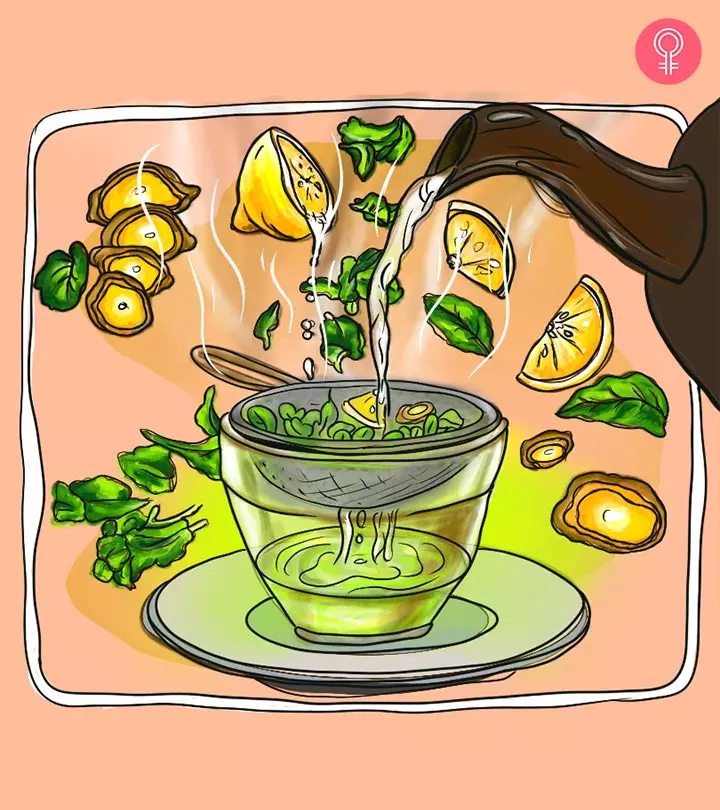
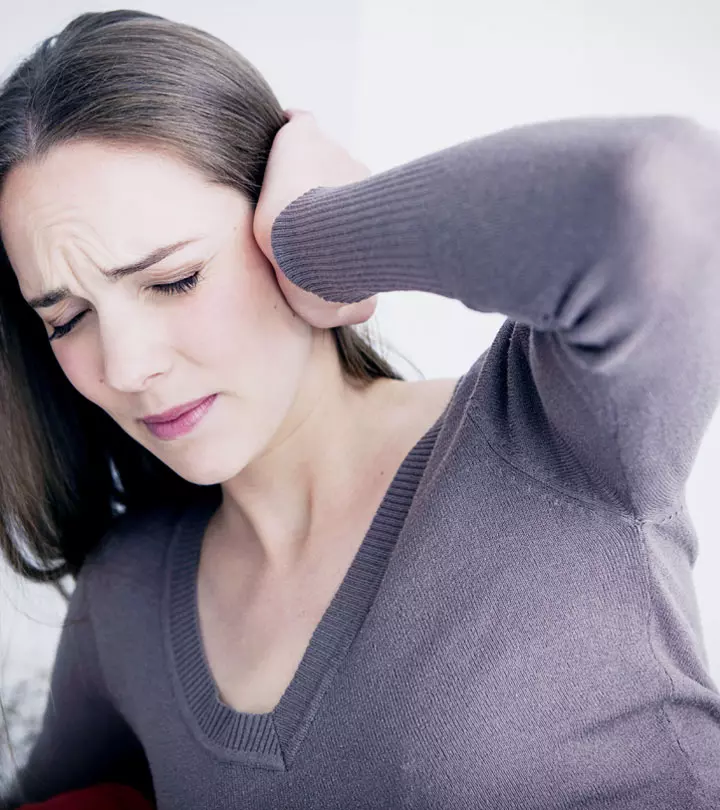
Community Experiences
Join the conversation and become a part of our empowering community! Share your stories, experiences, and insights to connect with other beauty, lifestyle, and health enthusiasts.